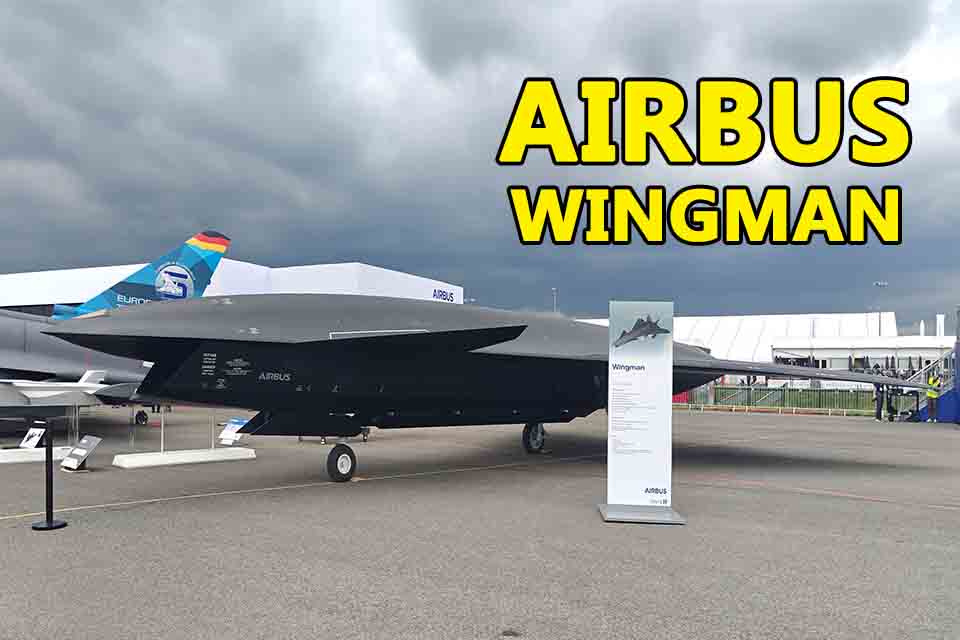Aerospace
Airbus presents new Wingman concept at ILA Berlin Airshow

At the prestigious ILA aerospace trade show in Berlin, Airbus Defence and Space made waves by introducing its pioneering Wingman concept, marking a significant leap forward in military aviation technology.
Teaming up with Helsing, Europe’s leading defense AI and software company, Airbus showcased a framework cooperation agreement aimed at revolutionizing the realm of artificial intelligence (AI) in defense.
Airbus Wingman
The Wingman concept represents a paradigm shift in aerial warfare, introducing unmanned platforms equipped with advanced AI capabilities to augment the capabilities of manned combat aircraft. Pilots in command aircraft such as the Eurofighter command these autonomous drones, positioning them to undertake high-risk mission tasks that would traditionally pose a significant threat to manned-only aircraft.
Central to the Wingman concept is Manned-Unmanned Teaming, wherein manned aircraft serve as “command fighters,” retaining ultimate control over mission decisions while delegating tactical tasks to unmanned systems. This synergistic collaboration promises to enhance mission flexibility, increase combat mass, and minimize risk exposure for pilots, thereby bolstering overall operational effectiveness.
The capabilities of the Wingman extend across a diverse spectrum of mission profiles, ranging from reconnaissance and target jamming to precision strikes against both ground and aerial targets. Equipped with advanced sensors, connectivity solutions, and a diverse array of armaments, the Wingman stands poised to redefine the operational landscape of modern air forces.
While the Wingman model showcased at ILA Berlin represents the pinnacle of current technological innovation, it also serves as a catalyst for future design iterations. As with any pioneering concept, refinement and evolution are inevitable, with each generation of the Wingman poised to push the boundaries of aerial warfare even further.
MQ-28 Ghost Bat
Boeing introduced the MQ-28 Ghost Bat, an unmanned combat aerial vehicle (UCAV), which made its maiden flight in February 2021. Developed by Boeing Australia, the MQ-28 leverages artificial intelligence to serve as a force multiplier for manned fighter jets.
The Ghost Bat is engineered to operate in tandem with existing military aircraft, enhancing and extending the capabilities of airborne missions. This cost-effective UCAV is designed to work as an intelligent teammate, complementing and amplifying the effectiveness of manned operations in various mission profiles.

Aerospace
Boeing Transfers Rocket Stage to NASA, Paving Way for Human Moon Mission

Boeing has achieved a significant milestone by providing NASA with the second core stage of the Space Launch System (SLS) rocket.
This crucial component, crafted at NASA’s Michoud Assembly Facility (MAF), is set to propel the Artemis II crew into lunar orbit, marking humanity’s return to deep space after a 50-year hiatus.
The monumental Boeing-built rocket stage, the largest element of the Artemis II mission, will embark on a journey aboard the Pegasus barge, traveling 900 miles to NASA’s Kennedy Space Center.
Comparison of two legendary aircraft B777x vs B747 aircraft:Click here
Upon arrival, it will be meticulously integrated with other essential Artemis II components, including the upper stage, solid rocket boosters, and NASA’s Orion spacecraft within the iconic Vehicle Assembly Building. This intricate integration process is a vital step toward the eagerly anticipated Artemis II launch, slated for 2025.
“Boeing-built products helped land humankind on the moon in 1969, and we’re proud to continue that legacy through the Artemis generation,” remarked Dave Dutcher, vice president and program manager for Boeing’s SLS program. “Together, with NASA and our industry partners and suppliers, we are building the world’s most capable rocket and paving the way to deep space through America’s rocket factory in New Orleans.”
NASA, Lockheed Martin Reveal X-59 Quiet Supersonic Aircraft:Click here
The delivery of Core Stage 2 marks a significant achievement in the evolution of the SLS rocket. Towering over 200 feet and powered by four RS-25 engines, this core stage, coupled with two solid-fueled booster rockets, will generate a staggering 8.8 million pounds of thrust. This immense power is crucial to launching Artemis II and future missions into the vast expanse of space.
The SLS rocket stands unparalleled in its capability to transport both crew and substantial cargo to the moon and beyond in a single launch. Its extraordinary capacity will facilitate the delivery of human-rated spacecraft, habitats, and scientific missions to destinations including the moon and Mars, ushering in a new era of space exploration.
-

 Travel1 week ago
Travel1 week agoAir India to Expand US Operations with Three New Routes After a Decade
-

 Travel2 weeks ago
Travel2 weeks agoWhy We Should Avoid These Stamps in a Passport
-

 Airlines1 month ago
Airlines1 month agoInvestigations Reveal Fake Chinese Titanium in Boeing and Airbus Jets
-

 Tech4 weeks ago
Tech4 weeks agoChina’s CATL Plans 1,800-Mile Electric Plane Launch by 2027
-

 Airport3 days ago
Airport3 days agoTop 10 Largest Airports in the World by Size
-

 Aerospace4 weeks ago
Aerospace4 weeks agoChina’s Fighter Jets Turn Wings into Autonomous Drones
-

 Airlines4 days ago
Airlines4 days agoAir India Rolls Out A350s for Delhi-New York JFK and Newark Routes
-

 Defence3 weeks ago
Defence3 weeks agoBoeing Enhances Chinook with New Engines and Block II Upgrades at $96 Million







